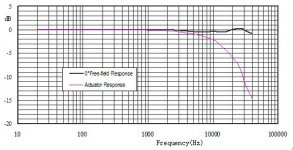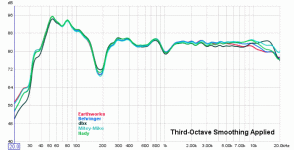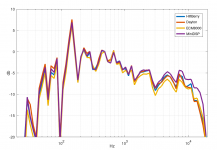Thank you all. It has started a new journey for me. Where I can find video,/description of ARTA/ REW guide or more helpful if there are step by step instructions, starting from how to connect and where to connect for different measurements. As I am new to this I need help starting from very basic steps.
The ARTA manual (and LIMP manual for the impedance box) should get you started. Don't bother too much about the mathematics, just read the practical stuff while you are running the app, preferably with sound card and DUT (device under test). That way you'll have more fun reading, you'll learn faster, you'll get around your setup better and you can use results in a sim app like VituixCAD, Xsim or Boxsim.
Alas, no one promised it would be easy, but the learning curve is doable. And very rewarding. And don't forget to visit the ARTA thread. Ivo Mateljan hangs around a lot here to answer even the 'dumbest' questions (no, those don't exist...).
Alas, no one promised it would be easy, but the learning curve is doable. And very rewarding. And don't forget to visit the ARTA thread. Ivo Mateljan hangs around a lot here to answer even the 'dumbest' questions (no, those don't exist...).
@profiguy, what do you mean by big? The capsules of the cheap electrets are 1/8” and in the Dayton and it’s varieties a 1/4” casing is used. That is the same as all 1/4” high end microphones from B&K, Gras and so on. Even a 1/2” microphone will easily do 20k, but the difference between on-axis and off-axis response will be bigger.
[edit]May I promote the Asio4all-drivers? They saved me discarding of a not supported anymore but otherwise perfect EMU0404.
You will get off axis discrepancy and ripple at higher frequencies with a larger capsule.
The EMM6 uses a 6mm capsule, but the mic body in front is 13mm diameter and that affects response.
Quite a few low buck companies use this generic mic body and likely the same capsule too. If you look at the Behringer ECM8000, Dayton EMM6 and MiniDSP Umik1, you'll see what I mean. They cut slots into the front tip right where the capsule sits, which modifies high frequency behavior on and off axis. This is typically done on diffuse field mics and has its own set of issues when compensating for its response if the mic is to be used for measuring or analyzing direct sound sources. There will be an early high end response rolloff with this type of mic and it needs to be corrected if you need good top end linearity.
Diffuse field mics are usually used for SPL measurements of a reverberant room or multiple sound/noise sources and aren't optimized for speaker measurement applications. A true omni pattern pressure gradient mic doesn't use a lense or wave guide of any sort. It just measures the pressure difference applied directly to the mic capsule diaphragm. It usually will have a slightly wide peak at its highest response range which has to be compensated for.
In the case of most cheap measurement mics, they behave like a combination of a diffuse field and pressure gradient mic, depending on how big the capsule is and the body directly housing it. All of the higher end measurement mics I've seen don't have any lenses or waveguides in front of the capsule.
I'm not a mic expert, but I've worked with companies like B+K, Schoeps and DPA in my line of acoustics work. I can tell you its pretty amazing you can get half way decent measurements from the cheap mics out there. If you want something better, you often have to pay proportionately far more.
Normally I use old Clio with calibration file for their microphone, but also have 1/4" RST prepolarized free field mic that runs on CCP power supply. The RST has slots cut in capsule to correct the freq resp above 1k. The Clio and RST are within 0.5dB up to 10kHz, to 20kHz within 1dB. Even without Clio calibration they are very close to 10kHz. I guess, I got lucky.
Anyway the most important is that your microphone is flat within the most important 20-10kHz to have good data for crossover work. Also there is measurement system by Dayton but again it's a few hundred $, but I never seen one in action so I won't comment.how it works.
Anyway the most important is that your microphone is flat within the most important 20-10kHz to have good data for crossover work. Also there is measurement system by Dayton but again it's a few hundred $, but I never seen one in action so I won't comment.how it works.
Attachments
Quite a few low buck companies use this generic mic body and likely the same capsule too. If you look at the Behringer ECM8000, Dayton EMM6 and MiniDSP Umik1, you'll see what I mean. They cut slots into the front tip right where the capsule sits, which modifies high frequency behavior on and off axis. This is typically done on diffuse field mics and has its own set of issues when compensating for its response if the mic is to be used for measuring or analyzing direct sound sources. There will be an early high end response rolloff with this type of mic and it needs to be corrected if you need good top end linearity.
Diffuse field mics are usually used for SPL measurements of a reverberant room or multiple sound/noise sources and aren't optimized for speaker measurement applications. A true omni pattern pressure gradient mic doesn't use a lense or wave guide of any sort. It just measures the pressure difference applied directly to the mic capsule diaphragm. It usually will have a slightly wide peak at its highest response range which has to be compensated for.
In the case of most cheap measurement mics, they behave like a combination of a diffuse field and pressure gradient mic, depending on how big the capsule is and the body directly housing it. All of the higher end measurement mics I've seen don't have any lenses or waveguides in front of the capsule.
I'm not a mic expert, but I've worked with companies like B+K, Schoeps and DPA in my line of acoustics work. I can tell you its pretty amazing you can get half way decent measurements from the cheap mics out there. If you want something better, you often have to pay proportionately far more.
That is really great information... thanks! I have been a bit disappointed with my EMM6 mic. The calibration curve looked like raw data points (very step-like sawtooth pattern) so I had to 1/3-octave smooth it. Now I find the calibration below 500 Hz is not accurate. I suppose I should not have expected a lot for $70.
I am now leaning towards the Audix TM1-plus. I am wondering about the difference between the Audix TM1 and the Earthworks M23R, other than the $200 price difference...
Cross Spectrum still does provide the correction data service, does it? I'd give that a try (over here we have a German company offering quite good correction files).
Measurement microphones traditionally fall apart in three categories: free field, pressure field and diffuse field types. For our purposes it actually isn't that important which type one uses. What is of importance is to know which correction should be applied at the various angles of incidence. We are mainly interested in free field measurements (unless you are working on room acoustics or with elaborate instruments like the Klippel NFS). The major brands offer correction curves at various angles and even the cheaper alternatives do give you 0 degree and 90 degree incidence correction. But you only have to point your mike in the direction of which you know the correction data.
To Jim: as I understand, the M23R is a selected M23 with a ruler flat (0,5dB within 20Hz-23kHz) response without correction. It should meet that part of the Class I specs, but not all of them obviously, otherwise Earthworks would have sold it with such a specification. If you are into Class I: budget wise MicW comes to mind and if you can raise the funds NTI is worth checking out.
Oh, and about diffuse field microphones: check out the B&K 4942. The protection grid has a slit pattern to improve the random incidence response.
Measurement microphones traditionally fall apart in three categories: free field, pressure field and diffuse field types. For our purposes it actually isn't that important which type one uses. What is of importance is to know which correction should be applied at the various angles of incidence. We are mainly interested in free field measurements (unless you are working on room acoustics or with elaborate instruments like the Klippel NFS). The major brands offer correction curves at various angles and even the cheaper alternatives do give you 0 degree and 90 degree incidence correction. But you only have to point your mike in the direction of which you know the correction data.
To Jim: as I understand, the M23R is a selected M23 with a ruler flat (0,5dB within 20Hz-23kHz) response without correction. It should meet that part of the Class I specs, but not all of them obviously, otherwise Earthworks would have sold it with such a specification. If you are into Class I: budget wise MicW comes to mind and if you can raise the funds NTI is worth checking out.
Oh, and about diffuse field microphones: check out the B&K 4942. The protection grid has a slit pattern to improve the random incidence response.
Last edited:
That is really great information... thanks! I have been a bit disappointed with my EMM6 mic. The calibration curve looked like raw data points (very step-like sawtooth pattern) so I had to 1/3-octave smooth it. Now I find the calibration below 500 Hz is not accurate. I suppose I should not have expected a lot for $70.
I am now leaning towards the Audix TM1-plus. I am wondering about the difference between the Audix TM1 and the Earthworks M23R, other than the $200 price difference...
The TM1 is on par with the Earthworks M30, just a tiny bit more self noise but almost half the price. It's definitely better than an M23 and will easily pick up the sharp breakup of a 1" metal dome tweeter which is usually just over 25k.
Low frequncy boundary and free field 1m measurements are reliable and repeatable with the TM1. I just did a recording of my son playing tenor sax through it and was shocked how clean and correct it sounds for a measurement mic. For music purposes, its almosft as good as the Neumann TLM103 ($1000 large diaphragm condenser) but it wont handle peaks very well over 135dB without going over 1% THD. Either way, not bad for a $300 measurement mic and useful for quite a few applications, not just measuring speakers.
- Home
- Loudspeakers
- Multi-Way
- New 2way bookshelf and crossover


